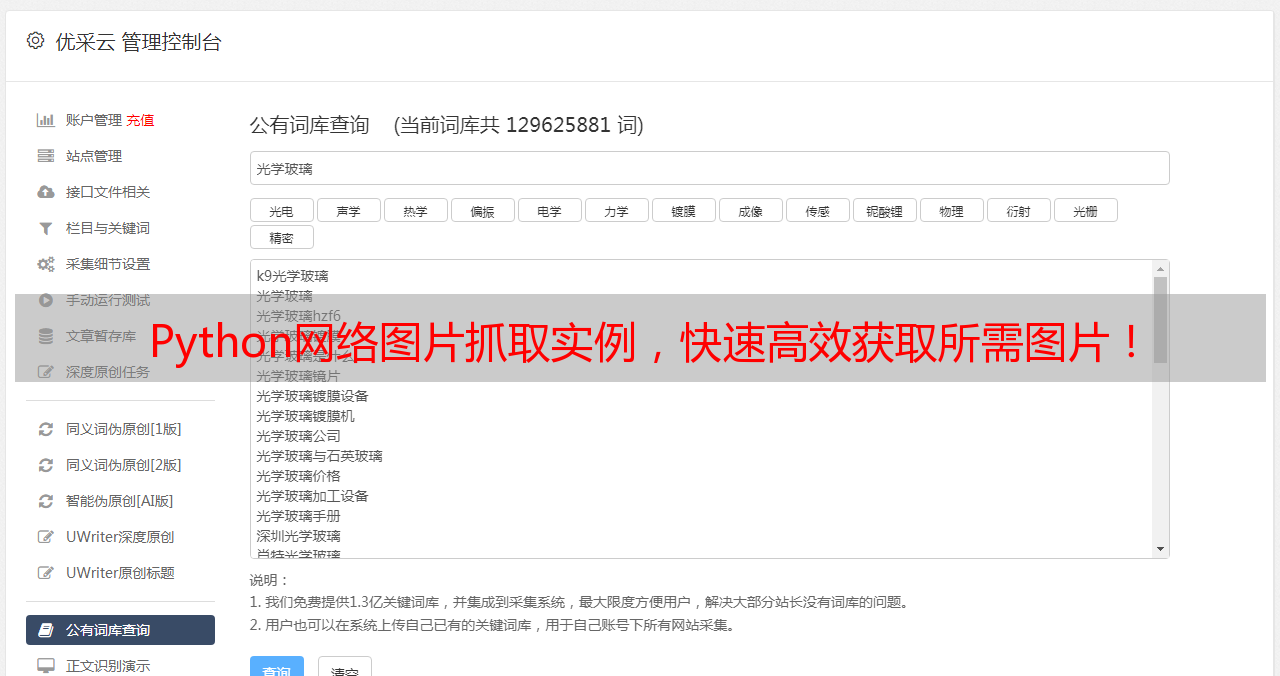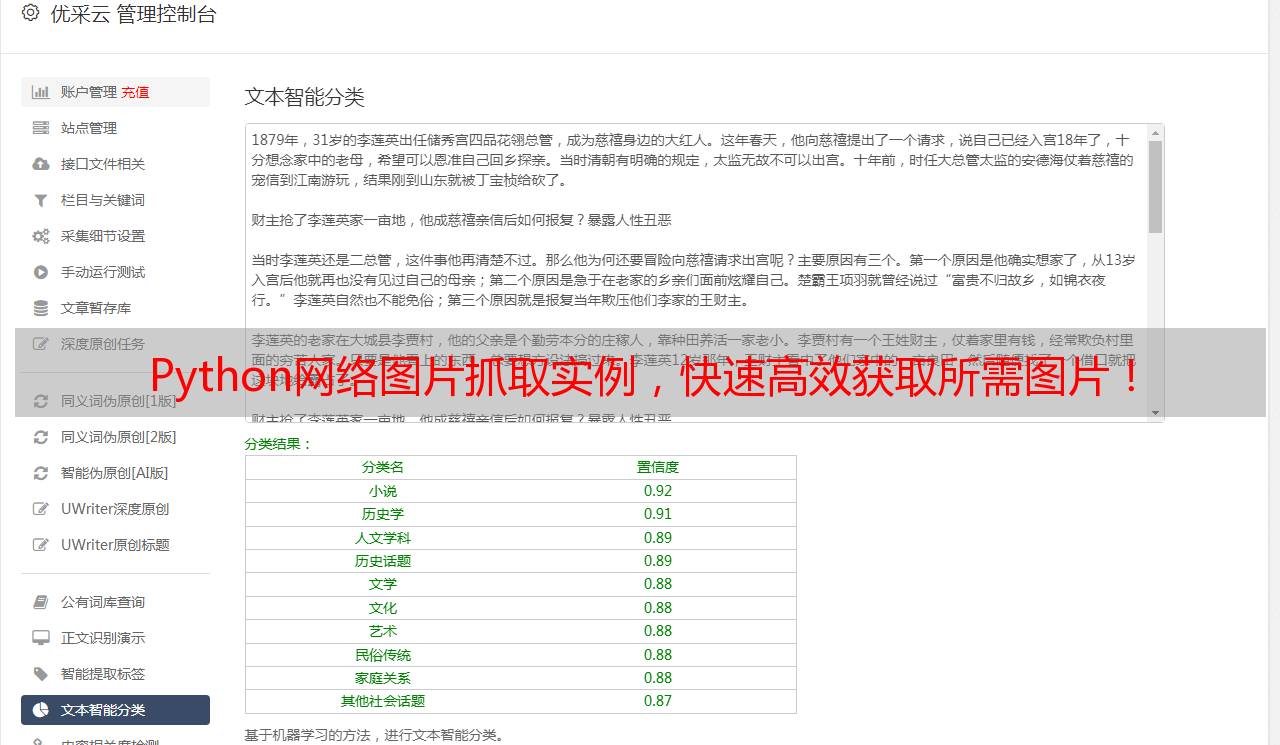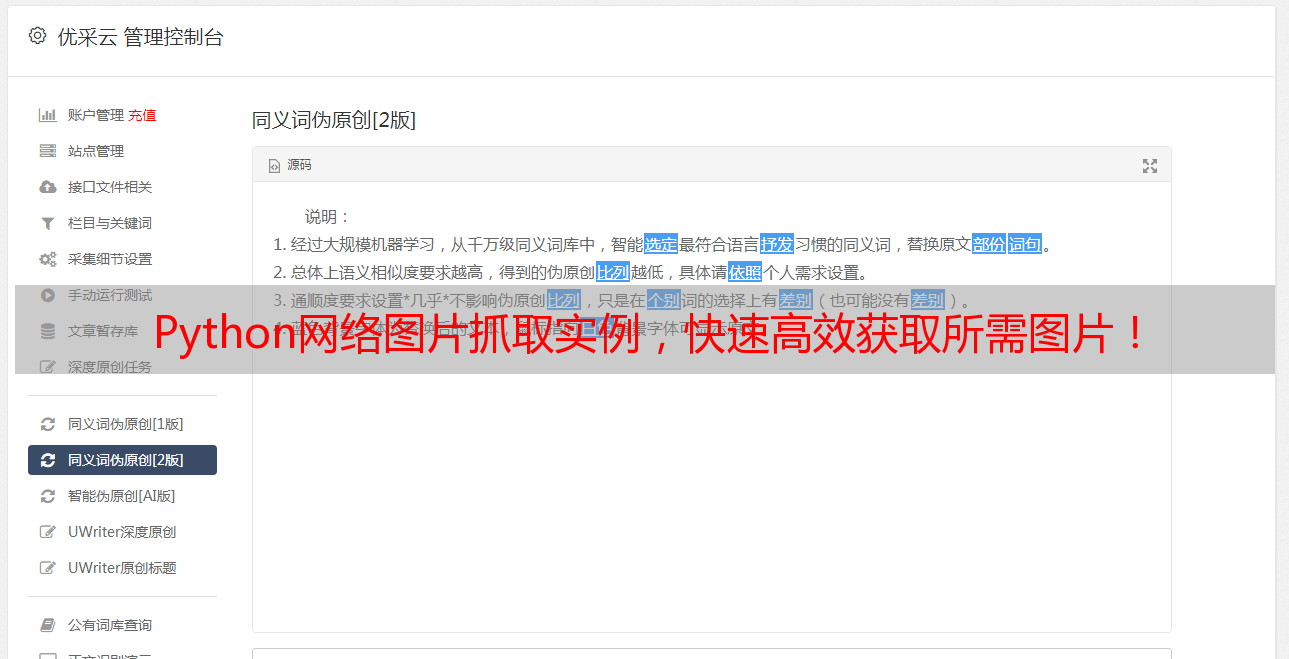Python网络图片抓取实例,快速高效获取所需图片!
优采云 发布时间: 2023-03-23 15:26随着互联网的发展,网络图片已经成为我们日常生活中不可或缺的一部分。在这个信息爆炸的时代,有时候我们需要搜索并下载大量的图片,以满足自己的需求。而 Python 作为一种快速、高效、易学易用的编程语言,可以帮助我们实现快速有效地抓取网络图片。本文将介绍如何使用 Python 抓取网络图片,并提供详细的代码和实例。
1.准备工作
在开始编写代码之前,我们需要先准备好所需的工具和环境。首先,在 Python 官网上下载并安装最新版本的 Python。其次,在命令行中使用 pip 安装必要的第三方库:requests 和 BeautifulSoup4。其中 requests 是一个 HTTP 库,可以发送 HTTP 请求,并获取响应;BeautifulSoup4 则是一个 HTML 解析库,可以解析 HTML 文档。
python
#安装requests库
pip install requests
#安装BeautifulSoup4库
pip install beautifulsoup4
2.获取图片链接
在抓取网络图片之前,我们需要先获取该网页上所有图片的链接。这里我们以百度图片为例进行演示。
python
import requests
from bs4 import BeautifulSoup
url ='https://image.baidu.com/'
response = requests.get(url)
soup = BeautifulSoup(response.text,'html.parser')
img_tags = soup.find_all('img')
urls =[]
for img in img_tags:
urls.append(img['src'])
print(urls)
3.下载图片
获取到所有图片链接之后,我们就可以开始下载这些图片了。这里我们使用 requests 库中的 get()方法来请求每个图片链接,并将响应内容保存到本地文件中。
3df75b7db8a1273208e75a69f66d23ee='images'#设置保存路径
if not os.path.exists(path):
os.makedirs(path)
for url in urls:
response = requests.get(url)
filename = os.path.join(path, url.split('/')[-1])
with open(filename,'wb') as f:
f.write(response.content)
4.处理异常情况
在实际使用过程中,可能会遇到各种异常情况,比如请求超时、文件名不合法等等。为了确保程序稳定性和健壮性,在代码中加入异常处理机制是非常必要的。
python
for url in urls:
try:
response = requests.get(url, timeout=10)
response.raise_for_status()
except Exception as e:
print('下载失败:',e)
continue
if not os.path.isdir(path):
os.makedirs(path)
filename = os.path.join(path, url.split('/')[-1])
if not os.path.splitext(filename)[-1] in ['.jpg','.png']:82ce8ed8b0dd81024f5368edb0e2f0ce+='.jpg'
with open(filename,'wb') as f:
f.write(response.content)
5.多线程下载
当需要下载大量图片时,单线程下载可能会比较慢。这时我们可以使用多线程来加速下载过程。这里我们使用 Python 中的 threading 模块来实现多线程下载。
python
import threading
class DownloadThread(threading.Thread):
def __init__(self, url):
super().__init__()
self.url = url
def run(self):
try:
response = requests.get(self.url, timeout=10)
response.raise_for_status()
filename = os.path.join(path, self.url.split('/')[-1])
with open(filename,'wb') as f:
f.write(response.content)
print(f'{filename}下载成功')
except Exception as e:
print(f'{self.url}下载失败:{e}')
threads =[]
for url in urls:
thread = DownloadThread(url)
threads.append(dc127f5d2483352fd20eaddb38feb6d2)
for thread in threads:
thread.start()
for thread in threads:
thread.join()
6.使用进度条显示下载进度
在下载大量图片时,很难判断当前进度和剩余时间。为了更好地展示下载进度,可以使用 tqdm 库来实现进度条显示功能。
python
from tqdm import tqdm
class DownloadThread(threading.Thread):
def __init__(self, url):
super().__init__()
self.url = url
def run(self):
try:
response = requests.get(self.url, timeout=10)
response.raise_for_status()
filename = os.path.join(path, self.url.split('/')[-1])
with open(filename,'wb') as f:
for chunk in tqdm(response.iter_content(chunk_size=1024)):
if chunk:
f.write(chunk)
print(f'{filename}下载成功')
except Exception as e:
print(f'{self.url}下载失败:{e}')
threads =[]
for url in urls:
thread = DownloadThread(url)
threads.append(dc127f5d2483352fd20eaddb38feb6d2)
for thread in threads:
thread.start()
for thread in threads:
thread.join()
7.设置代理服务器
有些网站可能会禁用 IP 地址或限制访问频率。为了解决这个问题,我们可以设置代理服务器来隐藏真实 IP 地址,并降低访问频率。
python
proxies={
"http":"http://127.0.0.1:1080",
"https":"http://127.0.0.1:1080",
}
response=requests.get(url,proxies=proxies)
8.验证码识别和处理
有些网站可能会设置验证码来防止机器人爬取数据。为了解决这个问题,我们需要使用 OCR 技术对验证码进行识别和处理。
python
from PIL import Image
import pytesseract
def recognize_code(image_file):
image=Image.open(image_file)
text=pytesseract.image_to_string(image)
return text
9.总结与展望
本文介绍了如何使用 Python 抓取网络图片,并提供了详细代码和实例。通过本文的学习,相信读者已经掌握了抓取网络图片的基本方法和技巧。当然,在实际应用中还有很多需要注意的地方,比如反爬虫机制、IP 封锁等等。因此,在今后的学习过程中,需要不断深入学习和探索相关知识,才能更好地应对各种复杂情况。
优采云(www.ucaiyun.com)是一家专业从事 SEO 优化服务的公司,在 SEO 优化领域拥有丰富经验和技术实力。如果您需要进行 SEO 优化或相关服务,请联系优采云获取更多信息。





